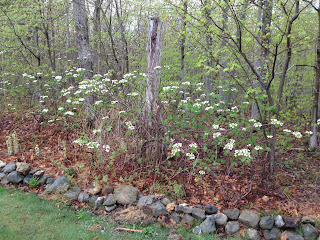 |
| White flowers in the Spring |
 |
| A good stand next to the 18th green |
Hobblebush is a native woody perennial that grows naturally around the course. Hobblebush is an understory plant found predominately in northeastern North American forests. For the past few weeks we have enjoyed its beautiful white flowers. It is a true Spring beauty. The golf course has provided many areas for this plant to flourish due to the "fringe" environments that have been created along the golf holes. Hobblebush is present in most of the forest understory. However, when sunlight is present the plant will flourish like it has at Stowe Mountain Club. Some people refer to this plant as "Moose Wood". It gets this name from the fact that during the winter the tops of the bush will be the only plant that is above the deep snow pack. Because of this, the moose will browse on the buds. Hobblebush is a staple in the moose diet during the winter.
Name: Viburnum lantanoides
Common Name: Hobblebush
Color: White
Bloom: Spring
Location: Golf course forest edges and tree islands
Use: Attracts early spring pollinators, stabilizes soil, provides food source for browsing mammals
USDA Plant Guide
Common Name: Hobblebush
Color: White
Bloom: Spring
 |
| Red berries in the Fall |
Use: Attracts early spring pollinators, stabilizes soil, provides food source for browsing mammals
USDA Plant Guide




